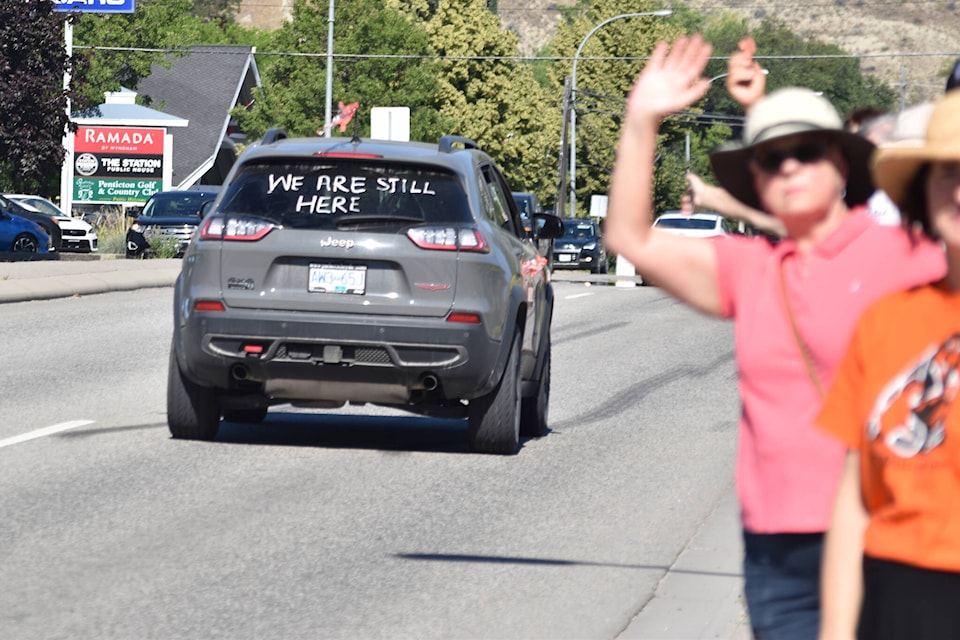Truth and Reconciliation Day will be marked on Sept. 30, according to the federal government and many people, including members of the Lower Similkameen Indian Band (LSIB), are wondering what the day is supposed to mean.
The Review reached out to Chief Keith Crow to speak with him and how he is approaching the government╬┌Đ╗┤ź├ŻÖs new holiday.
╬┌Đ╗┤ź├ŻťI╬┌Đ╗┤ź├ŻÖve been getting asked by a lot of people, ╬┌Đ╗┤ź├ŻśWell what does this actually mean?╬┌Đ╗┤ź├ŻÖ and honestly, I haven╬┌Đ╗┤ź├ŻÖt been able to give them an answer,╬┌Đ╗┤ź├ŻŁ said Crow.
╬┌Đ╗┤ź├ŻťI╬┌Đ╗┤ź├ŻÖve been getting different government agents calling me and asking what they╬┌Đ╗┤ź├ŻÖre supposed to be doing.╬┌Đ╗┤ź├ŻŁ
The federal government announced shortly before the election that Sept. 30, would become the new statutory holiday.
Little direction or conversations were provided by the government following that announcement on how the holiday should be observed, which is leading to many questions. Even within the LSIB, there are different views between different people on the day as well as on Truth and Reconciliation itself.
Many of those questions have arisen from the national conversations that contributed to the holiday declaration following the Indigenous children╬┌Đ╗┤ź├ŻÖs graves that were discovered this year.
╬┌Đ╗┤ź├ŻťThink about Thanksgiving. There are so many different aspects to what Thanksgiving actually is but in my family, we╬┌Đ╗┤ź├ŻÖre thankful for what we have, where we are and what family we╬┌Đ╗┤ź├ŻÖre with and that╬┌Đ╗┤ź├ŻÖs how we celebrate it,╬┌Đ╗┤ź├ŻŁ said Crow.
╬┌Đ╗┤ź├ŻťHow do you celebrate a Truth and Reconciliation Day? How do you celebrate the death of all these children that died in residential schools, how do you celebrate that?
╬┌Đ╗┤ź├ŻťIt╬┌Đ╗┤ź├ŻÖs like Remembrance Day almost, which is thanking the ones that gave us the freedom that we have, but how do we do that with the death of children?╬┌Đ╗┤ź├ŻŁ
Crow spoke on how he personally felt disappointed with exactly how the holiday came about and its timing, and the lack of substance around the government╬┌Đ╗┤ź├ŻÖs part in what is supposed to bring awareness.
╬┌Đ╗┤ź├ŻťI╬┌Đ╗┤ź├ŻÖm speaking personally here, not for my community, it╬┌Đ╗┤ź├ŻÖs hard. It╬┌Đ╗┤ź├ŻÖs a hard discussion,╬┌Đ╗┤ź├ŻŁ said Crow. ╬┌Đ╗┤ź├ŻťFor me, there has to be education behind it.
╬┌Đ╗┤ź├ŻťIt╬┌Đ╗┤ź├ŻÖs difficult, because if you want people to know the truth, then the proper education has to be out there to understand what it means, and right now, a lot of people can╬┌Đ╗┤ź├ŻÖt handle that conversation.
One example of a conversation that Crow had with a member of the government looking for guidance highlights the lack of knowledge and understanding of the knowledge behind the government╬┌Đ╗┤ź├ŻÖs reasoning for the holiday, particularly for the events and the around the residential school system that only officially closed in 1996.
╬┌Đ╗┤ź├ŻťI told the one guy, go be with your kids. I want you to think about this; imagine being told that you had to put your kids on this truck, to ship your kids away to a school where you know they are going to be abused and they may not come home, and you don╬┌Đ╗┤ź├ŻÖt have an option. And if you say no you╬┌Đ╗┤ź├ŻÖll be arrested. He couldn╬┌Đ╗┤ź├ŻÖt think of it.╬┌Đ╗┤ź├ŻŁ
Going forward, Crow expressed his hope that there is more than just a single day, and that more education will lead to actual truth and reconciliation beyond a single holiday.
╬┌Đ╗┤ź├ŻťStep up to the plate government, how are you going to right your wrongs,╬┌Đ╗┤ź├ŻŁ said Crow.
╬┌Đ╗┤ź├ŻťTruth and Reconciliation is an action, it╬┌Đ╗┤ź├ŻÖs not a day off.╬┌Đ╗┤ź├ŻŁ
To report a typo, email: editor@pentictonwesternnews.com.
<>
newstips@pentictonwesternnews.com
Like us on and follow us on .



